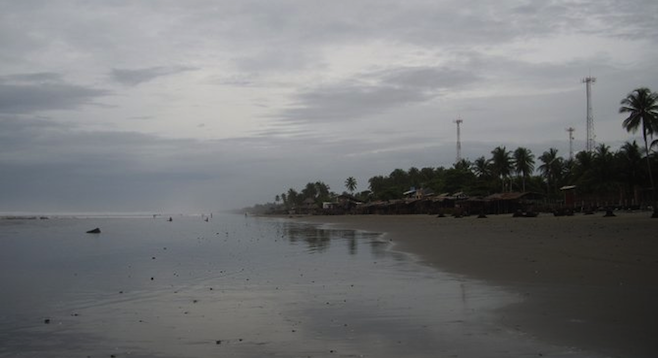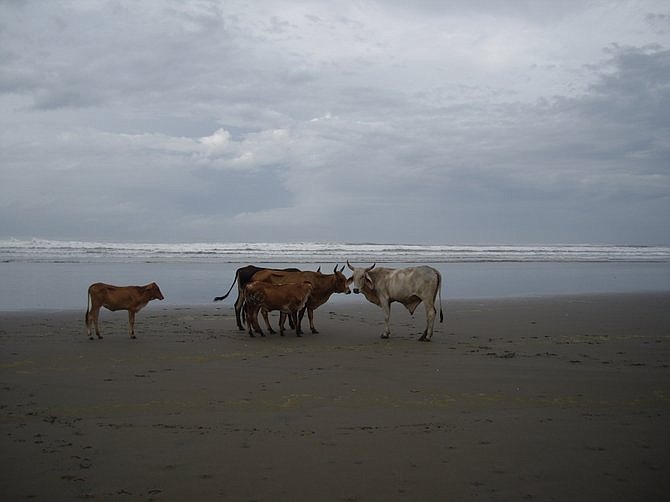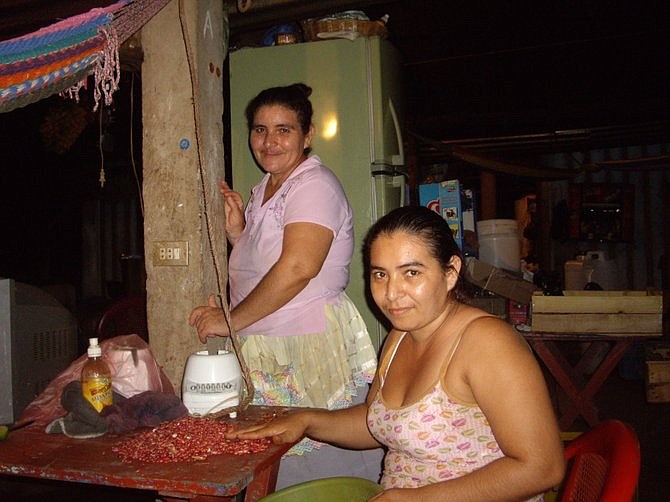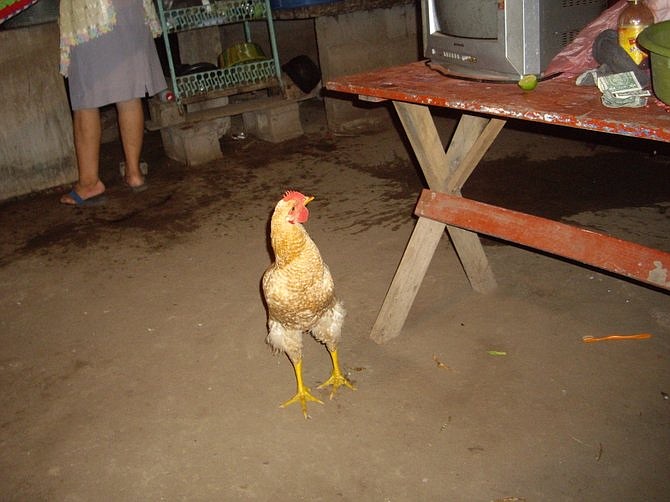 Facebook
Facebook
 X
X
 Instagram
Instagram
 TikTok
TikTok
 Youtube
Youtube


Call me a spoiled Southern Californian, but until I visited Playa El Espino I had never been forced to walk through a herd of milling cattle (left) to get to the ocean. This small fishing wannabe-resort village clings to the southeastern Pacific coast of El Salvador.
Its intentions are good, and the nation itself seems to be behind the development. Starting at the San Salvador airport, road signs mark off the 146 kilometers until you reach this chosen destination.
Having spent the majority of our time surfing the western El Salvadorian beaches, we decided to see what the east held for us.
Throwing caution to the wind, we disregarded the time-honored advice of not driving after dark in a developing country. After about 15 minutes on the two-lane Highway 2, the skies opened up and a downpour began.
The limited visibility combined with a hodgepodge of vehicles in various lighted states caused our progress to slow to a crawl. What the guidebook said was a two-hour drive had turned into over three by the time we turned west to head for the beach. Even though the rain had now stopped and the sky had cleared, it took us another 40 minutes to navigate the hairpin curves until at last we arrived at the end of the road.
The “End of the Road” proved to be both metaphoric and literal. It was dark – as in not only no street lights, but no lights. Period. Forced with a right or left decision, we went right, proceeding down a narrow lane, our car limping along the broken concrete. High walls on each side prevented any idea of our surroundings. Of the town’s estimated population of 400, we saw but one soul. He, like everyone we met in this Central American country, was polite and helpful. At his beckoning, we followed him another 100 yards down the road. Here he proceeded to pound on a wooden gate until the proprietor of the establishment opened it.
We were told that there were rooms, but the kitchen and bar were closed. After taking a look at the room our standing joke of “we’ve stayed in worse places” no longer seemed funny or accurate. Since our other choices seemed slim and none, we paid the overpriced $20 and moved into our accommodations.

Having found bedding for the night, food became of utmost importance. We'd seen a small store about 10 miles back on our drive in, but it was closed on our return. Hungry and disappointed, we turned back towards our hotel. But this time as we neared the town we saw some lights and moved towards them. It was difficult to determine if it was a restaurant or someone’s house. Urged on by empty stomachs we decided to enter.

Somewhat surprised by three gringos emerging from the darkness, the women washing dishes recovered enough to explain that all they had left were frijoles, casa and cerveza. The table and chairs were plastic and the floor was dirt. A chicken and a pig kept us company during dinner. Certainly no “cheeseburgers in paradise,” but I can’t remember food tasting much better than those hot beans and cold beer.
I woke early the next morning to the sounds of the surf. Other than the aforementioned bovine the six-mile beach was deserted. Numerous hotels and houses in various states of repair and construction came into view. Cell towers rose from the jungle, but there were no people. Even as the day wore on we saw only a few families enjoying the beach.
Playa El Espino certainly has potential. Whether it will ever become another resort-style mecca in Central America remains to be seen. The beach and the beauty are certainly there, but for now it remains a quite, quaint, sparsely populated little village.



Call me a spoiled Southern Californian, but until I visited Playa El Espino I had never been forced to walk through a herd of milling cattle (left) to get to the ocean. This small fishing wannabe-resort village clings to the southeastern Pacific coast of El Salvador.
Its intentions are good, and the nation itself seems to be behind the development. Starting at the San Salvador airport, road signs mark off the 146 kilometers until you reach this chosen destination.
Having spent the majority of our time surfing the western El Salvadorian beaches, we decided to see what the east held for us.
Throwing caution to the wind, we disregarded the time-honored advice of not driving after dark in a developing country. After about 15 minutes on the two-lane Highway 2, the skies opened up and a downpour began.
The limited visibility combined with a hodgepodge of vehicles in various lighted states caused our progress to slow to a crawl. What the guidebook said was a two-hour drive had turned into over three by the time we turned west to head for the beach. Even though the rain had now stopped and the sky had cleared, it took us another 40 minutes to navigate the hairpin curves until at last we arrived at the end of the road.
The “End of the Road” proved to be both metaphoric and literal. It was dark – as in not only no street lights, but no lights. Period. Forced with a right or left decision, we went right, proceeding down a narrow lane, our car limping along the broken concrete. High walls on each side prevented any idea of our surroundings. Of the town’s estimated population of 400, we saw but one soul. He, like everyone we met in this Central American country, was polite and helpful. At his beckoning, we followed him another 100 yards down the road. Here he proceeded to pound on a wooden gate until the proprietor of the establishment opened it.
We were told that there were rooms, but the kitchen and bar were closed. After taking a look at the room our standing joke of “we’ve stayed in worse places” no longer seemed funny or accurate. Since our other choices seemed slim and none, we paid the overpriced $20 and moved into our accommodations.

Having found bedding for the night, food became of utmost importance. We'd seen a small store about 10 miles back on our drive in, but it was closed on our return. Hungry and disappointed, we turned back towards our hotel. But this time as we neared the town we saw some lights and moved towards them. It was difficult to determine if it was a restaurant or someone’s house. Urged on by empty stomachs we decided to enter.

Somewhat surprised by three gringos emerging from the darkness, the women washing dishes recovered enough to explain that all they had left were frijoles, casa and cerveza. The table and chairs were plastic and the floor was dirt. A chicken and a pig kept us company during dinner. Certainly no “cheeseburgers in paradise,” but I can’t remember food tasting much better than those hot beans and cold beer.
I woke early the next morning to the sounds of the surf. Other than the aforementioned bovine the six-mile beach was deserted. Numerous hotels and houses in various states of repair and construction came into view. Cell towers rose from the jungle, but there were no people. Even as the day wore on we saw only a few families enjoying the beach.
Playa El Espino certainly has potential. Whether it will ever become another resort-style mecca in Central America remains to be seen. The beach and the beauty are certainly there, but for now it remains a quite, quaint, sparsely populated little village.
Comments